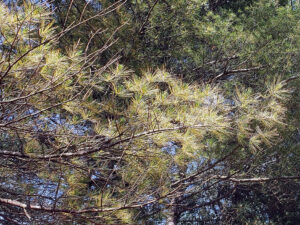
Current-year white pine needles emerge among yellow needles that show spots and banding. / Photo Credit: Linda Williams, Wisconsin DNR
By Linda Williams, DNR Forest Health Specialist, Woodruff
Linda.Williams@wisconsin.gov or 920-360-0665
In North Central Wisconsin, some Eastern white pine had needles that turned a bright yellow color in early June, then quickly dropped from the trees by the end of June.
These trees will now look rather thin throughout the summer, until new foliage can fully expand and start to fill in the crown. Most damage has been noted in Oneida and Vilas counties, with scattered instances in other counties.

Bright yellow needles on white pine appeared during the first two weeks of June 2025, likely caused by needle disease. / Photo Credit: Linda Williams, Wisconsin DNR
Septorioides needle blight (Septorioides strobi) is the primary suspect, but in past years, brown spot needle blight (Lecanosticta acicula, previously known as Mycosphaerella dearnessii) and Lophodermium spp. have also been isolated from samples. This year, samples were sent to the Wisconsin Department of Natural Resources (DNR) Forest Health laboratory to determine which fungal species were present.
In the eastern United States, an issue referred to as white pine needle damage consists of a combination of Septorioides, brown spot needle blight and Lophodermium, in addition to Dooks needle blight (Lophophacidium dooksii, formerly Canavirgella banfieldii) and Bifusella linearis. This complex of fungi is causing branch mortality and tree decline in northeastern states after repeated years of defoliation. We have not observed this level of tree decline in Wisconsin.
Losing a large number of needles can stress trees, especially if they undergo consecutive years of needle disease. Yard trees that were severely impacted should be watered if there are dry, droughty conditions during summer or fall. Trees in forests may need a couple of years to produce a full complement of needles.
